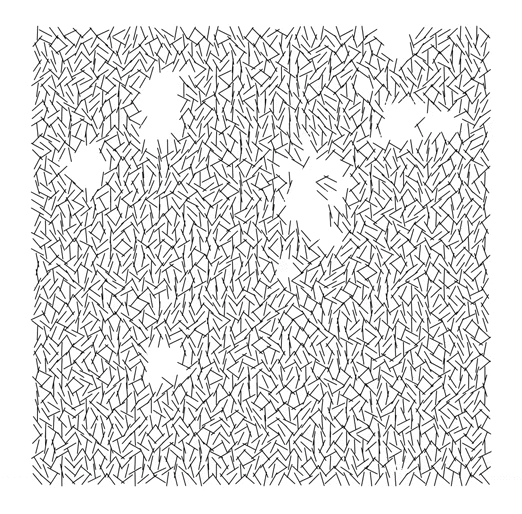Observations:
- The artwork is square.
- There is a border of white along the edges.
- The lines all tend to have a bias toward vertical or horizontal in each piece, from a further away view.
- Very few individual lines are rotated anywhere near horizontal(for the vertically oriented pieces).
- Open areas between lines seem to have fairly uniform, if random shapes.
- The lines look like they line up in a grid, with each line rotated about its midpoint.
- The lines are all short and have the same length
- The lines are black. The background is white.
- The larger open spaces have irregular shapes and are fairly sparse.
- Some of the large open spaces occur at the 'edges' and there are no lines in that part of the edge.
- There are lots of small parallelograms, triangles, and sometimes pentagons formed by adjacent lines.
- There are at least fifty lines in a row/column.

var boolDoRefresh; var boolDoRefresh; var bkgrd = 255; var canvasW = 650; var canvasH = 650; var border = 30; var gridSize = 56; var baseAngle = 90; //change to 0 for horizontal orientation var lineRadius = 9; function setup() { createCanvas(canvasW, canvasH); boolDoRefresh = true; background(bkgrd); noFill(); angleMode(DEGREES); } function draw() { if (boolDoRefresh) { drawTheThing(); boolDoRefresh = false; } } function drawTheThing(){ var div = (width - 2*border)/gridSize; var noiseVal; var noiseScale=0.01; for (var x = border; x < width - border; x += div){ for (var y = border; y < width - border; y += div){ noiseDetail(3,0.7); noiseVal = noise((x) * noiseScale, (y) * noiseScale); if(noiseVal > 0.75) stroke(255); else stroke(0); drawLineCenteredAt(x,y); } } } function drawLineCenteredAt(x,y){ var angle, dx, dy, bias; bias = 65; angle = baseAngle - random(bias); var half = random(2); var neg; if (half < 1) neg = -1; else neg = 1; dx = neg*lineRadius*cos(angle); dy = lineRadius*sin(angle); line(x+dx,y+dy, x-dx,y-dy); } function mousePressed() { noiseSeed(random(100)); background(bkgrd); boolDoRefresh = true; } |
Some Thoughts
I started with the general form, a grid of randomly rotated lines, then added in noise, then fine-tuned the lines' randomness. The vertical/horizontal bias was interesting. The angle rotated definitely had to be less than 90 degrees, but I wasn't sure if the angle deviation was constant or formed a kind of bell curve around a point(ultimately it made little difference). The noise was also difficult because understanding what the different settings meant didn't translate to imagining what the overall effect would be, so it was a lot of testing and close comparison. I learned to appreciate examining an art piece in extremely great detail and seeing what kind of fiddling went into achieving that specific impression. I think I made a good copy at a glance, although I think the noise could have been less harsh.